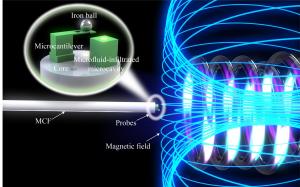3D printed multicore fiber-tip discriminative sensor for magnetic field and temperature measurements
USA, August 28, 2024 /EINPresswire.com/ -- Miniaturized fiber-optic magnetic field sensors have attracted intensive interests due to the superiorities of anti-electromagnetic interference and compactness. Scientist in China developed an ultracompact multicore fiber (MCF) tip probes for magnetic field and temperature discriminative sensing. The size of the whole sensing probes does not exceed the inherent outer diameter of the MCF, which means a significant reduction in the size of multi-parameter sensor. The technique will open new avenues towards the realization of an all-fiber miniaturized multi-parameter sensor.
Magnetic field sensing plays a pivotal role in numerous fields of medical, transportation and aerospace. The optical fiber-based magnetic field sensor possesses outstanding characteristics of compactness, long-distance interrogation, low cost and high sensitivity, which has attracted intensive interests. However, the fiber-based magnetic field sensor is generally affected by the temperature perturbation. Recently, although the temperature crosstalk can be effectively eliminated by integrating multiple sensing elements, it is at the cost of increasing the size of the whole sensing components, and the different spatial location of multiple elements could cause the measurement error in the multi-parameter discriminative sensing.
In a new paper (https://doi.org/10.37188/lam.2024.018) published in Light: Advanced Manufacturing, a team of scientists, led by Professor Limin Xiao from Advanced Fiber Devices and Systems Group, Key Laboratory of Micro and Nano Photonic Structures (MoE), Key Laboratory for Information Science of Electromagnetic Waves (MoE), Shanghai Engineering Research Center of Ultra-Precision Optical Manufacturing, School of Information Science and Technology, Fudan University, China, and co-workers have developed an ultracompact multicore fiber (MCF) tip probes for magnetic field and temperature discriminative sensing. A bowl-shaped microcantilever and a microfluid-infiltrated microcavity were printed on two different cores of an MCF via the two-photon polymerization (TPP) technique, respectively. The microcantilever was incorporated with an iron ball inside the bowl-shaped tip to make it magnetically sensitive, while the microfluid-infiltrated microcavity provided a highly sensitive temperature sensing element. The discriminative measurement of two parameters can be realized by a sensitivity coefficient matrix. The technique can not only implement the discriminative sensing of magnetic field and temperature with high sensitivity, but also significantly reduce the size of multi-parameter sensor.
The proposed 3D printed MCF-tip probes, with the capability of detecting multi-signal on a tiny fiber tip through multi-channels within a single fiber, can provide an ultracompact, sensitive and reliable scheme for discriminative measurement when the sensing space is extremely limited in size. In addition, being able to print probes in an on-demand fashion could accelerate the research where MCF-tip printed structure could be easily adapted for use in specialized situations.
“The bowl-shaped microcantilever can also provide a useful platform for incorporating microstructures with fruitful functional materials, extending the multi-parameters sensing scenarios, and promoting applications of MCFs.” the scientists forecast.
DOI
10.37188/lam.2024.018
Original Source URL
https://doi.org/10.37188/lam.2024.018
Funding information
This work was supported by the National Natural Science Foundation of China (No. 62275052, No.62275148), the Jiangsu Province's Industry Outlook and Key Core Technologies-Key Projects (BE2022055-4), the Open Fund of Laboratory of Science and Technology on Marine Navigation and Control, China State Shipbuilding Corporation (2023010102).
Lucy Wang
BioDesign Research
email us here
Legal Disclaimer:
EIN Presswire provides this news content "as is" without warranty of any kind. We do not accept any responsibility or liability for the accuracy, content, images, videos, licenses, completeness, legality, or reliability of the information contained in this article. If you have any complaints or copyright issues related to this article, kindly contact the author above.

